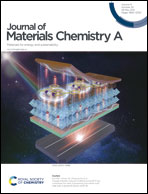Cathodic corrosion activated Fe-based nanoglass as a highly active and stable oxygen evolution catalyst for water splitting†
Abstract
Transition metal-based amorphous alloys have attracted increasing attention as precious-metal-free electrocatalysts for oxygen evolution reaction (OER) of water splitting due to their high macro-conductivity and abundant surface active sites. However, the catalysis of bulk amorphous alloy only originates from a few atomic layers of the surface, and the catalytic activity usually rapidly decreases due to the coverage of corrosion products during the OER process. Here, we report a Fe78Si9B13 nanoglass covered by in situ formed FeOOH (FeOOH@NG) that can perfectly combine self-activation and synergistic catalysis between volume and surface, leading to high activity, fast reaction kinetics, and stability of activity for OER. The Fe78Si9B13 nanoglass with abundant ordered boundaries introduced in the amorphous matrix is prepared via melt-spinning followed by high-pressure torsion (HPT). Afterwards, a FeOOH layer is introduced on the surface of the nanoglass by a cathodic corrosion activation method. The FeOOH layer not only exposes more active sites, but also generates hydroxyl radicals (OH) in oxygen vacancies to activate the Fe-based nanoglass matrix. The FeOOH@NG generates an overpotential of only 240 mV at 10 mA cm−1 in 1 M KOH, and the Tafel slope is as low as 42 mV dec−1.



 Please wait while we load your content...
Please wait while we load your content...